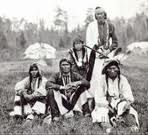Chippewa nation
Chippewa
Indian Nation of Wisconsin and Minnesota 
The Chippewas, first befriended the French, allied themselves with the British during the American War of Independence. The United States impose a treaty in 1837 which removed most of their land. They currently live on small reservations in Minnesota and Wisconsin.
The board of the three nations
Called "Chippewa" in the United States and "Ojibwa" in Canada, their real name is "Anishinabe".
Constituting a nation strong and numerous, the Chippewas are in the seventeenth century Algonquins who lived west of Lake Superior, a country of great forests, lakes and rivers. They were now closely linked to the Ottawas and Potawatomi, forming with them the Council of Three Nations.
The Chippewas lived in villages made of fixed conical wigwams covered with bark and skins. The men hunted deer, bear and deer, fished in the many lakes and rivers. The women had small gardens where they grew corn green beans, pumpkin. One of the most important crops for the Chippewas was that of the wild rice, "menomin", which is not rice but a tall grass like oats, growing in abundance along the lakes. Women and young men gathered up the rice in boats, while the hunters hunted waterfowl. The Chippewas were renowned for the beauty and lightness of their bark canoes.
The company "Midewiwin"
Like other peoples of the Great Lakes region, the Chippewas were attending a shamanic society, the "Midewiwin", called "Grand Medicine Society". Whoever wanted to enter had to prove to have been visited in dreams by a spirit. He was then initiated at a secret meeting held once a year. One member, serving as secretary, noted the events on a bark with engraved signs and red paint. Each member of society was a "plasmid" or "medicine bag" made with the skin of the animal whose spirit had inspired and containing elements from animals, plants or stones whose power was required help those who wore them.
Like other Algonquian peoples, the Chippewas believed in the omnipotence of a master spirit called Manito.
Allies of the French
In the late seventeenth century, the Chippewas became allies of the French in the important fur trade. The French provide them hundreds of muskets which the Chippewas use to hunt, but also to attack their neighbors without firearms, Sioux, Fox, Kickapoo, and stand up to powerful Iroquois. They thus extend their ranges southward, the current states of Wisconsin and Minnesota, while others are moving away to Manitoba and adopt the following century the nomadic lifestyle of the Plains Indians.
They remain faithful to the French, fighting with them in the Anglo-French war which was to end with the Treaty of Paris in 1763 and continue the war against the British along with Pontiac. In 1769, allied with the Sauk and Fox and Kickapoo, they destroy in part the Illinois living south to avenge the death of Pontiac assassinated by an Illinois.
Including the danger posed to the Indian peoples expansionism of American settlers, they will support the British during the War of Independence, then will join the coalition assembled by Little Turtle from 1791 to 1794 and that Tecumseh, 1812-1813 .
As in many Indian nations of the Northeast, the young United States will pay to the Chippewas to their hostile attitude. By 1815, they are forced to yield to American colonists most of their territory, leaving only scattered reservations.
In 1837, they signed a new treaty with the United States further reducing their land, their rights guaranteed, however, hunting, fishing and gathering firewood, berries and wild rice on some of their former territory.
The Chippewas hold reserves of Red Lake, Leech Lake, White Earth, Fond du Lac, Mille Lac, Bois Forte and Grand Portage, Minnesota, and Bad River, Lac Courte Oreilles and Red Cliff, Wisconsin. The Turtle Mountain Chippewa reservation is located in North Dakota.
Leech Lake (1898)
After the massacre of Lakota at Wounded Knee Creek in 1890, the Indian wars are deemed complete. However, a recent war would break out in 1898 on the Leech Lake Chippewa reservation in Minnesota.
The Indians have long protested against the repeated encroachments of farmers on their reservation, but their complaints to the authorities remain unanswered. The situation becomes very tense between whites and Indians.
So when two Indians accused of having introduced the alcohol on the reservation, are apprehended, the Chippewas are arming themselves, determined to deliver them. General Bacon, head of a hundred men, enters the reserve and stops one of the leaders.
October 5, Chippewa identify the soldiers as they bivouacked. A gunfire broke out between the two opposing lines and lasts several hours, killing seven and fifteen wounded soldiers. The next day, fearing an uprising of large-scale, large reinforcements were dispatched to the scene. The Chippewas, in a spirit of reconciliation, agree to deliver trouble-makers who will ultimately be sentenced to prison terms of light.
Throughout the region, armed militias had already formed in the hope, soon disappointed, a new Indian war. But calm returned quickly.
the "American Indian Movement"
The Chippewas have been fighting for years to continue to exercise their fishing rights guaranteed by the Treaty of 1837 in some Wisconsin lakes, despite the violent opposition of anti-Indian. They are also trying to save for economic and cultural fields of wild rice seriously threatened by pollution of lakes. In Montana, the Chippewa West share the Rocky Boys reservation with the Plains Cree.
Since the 1960s, marked by the policy of "relocation", many Chippewas settled in St. Paul, near Minneapolis, where they face serious social problems.
In 1968 only two Chippewas, John Mitchell and Dennis Banks, soon joined by brothers Clyde and Vernon Bellecourt, Minneapolis create the "American Indian Movement" (AIM) to support and protect urban Indians and to be in the years 1970-1980, the Indian protest movement's most powerful and most radical.
A découvrir aussi
Inscrivez-vous au site
Soyez prévenu par email des prochaines mises à jour
Rejoignez les 76 autres membres
